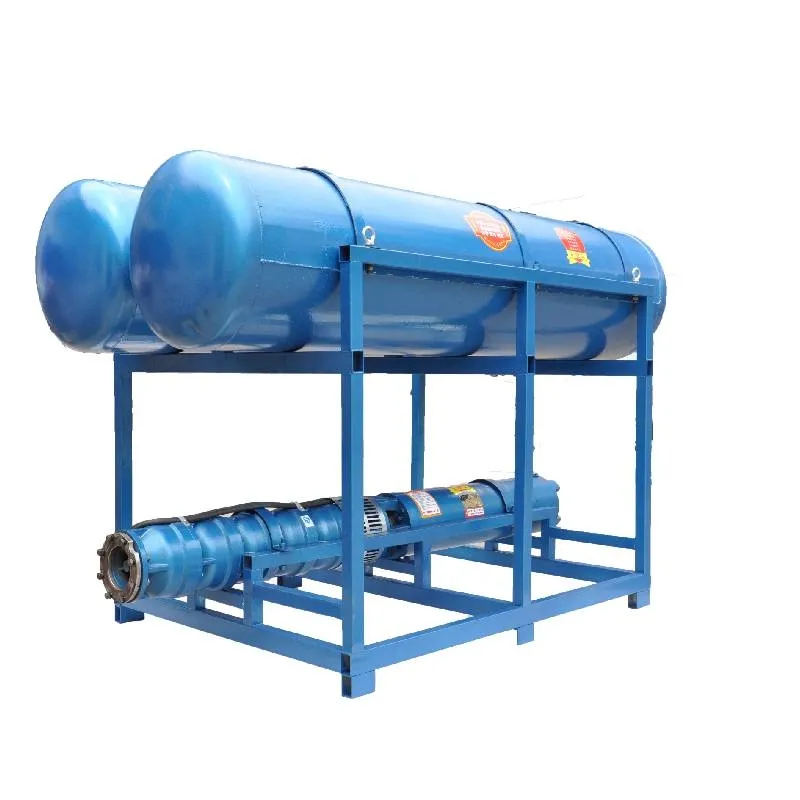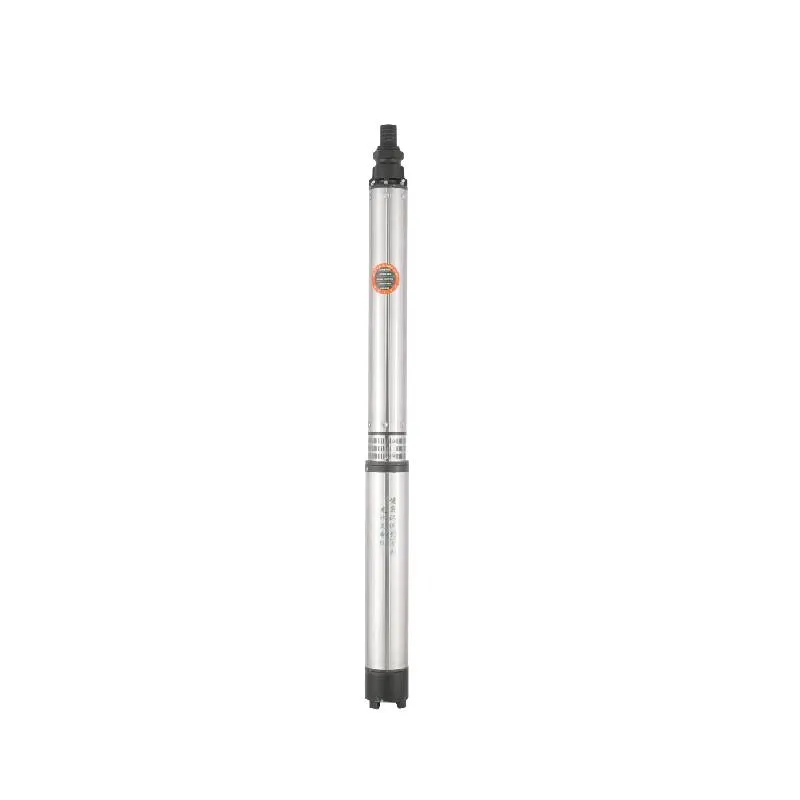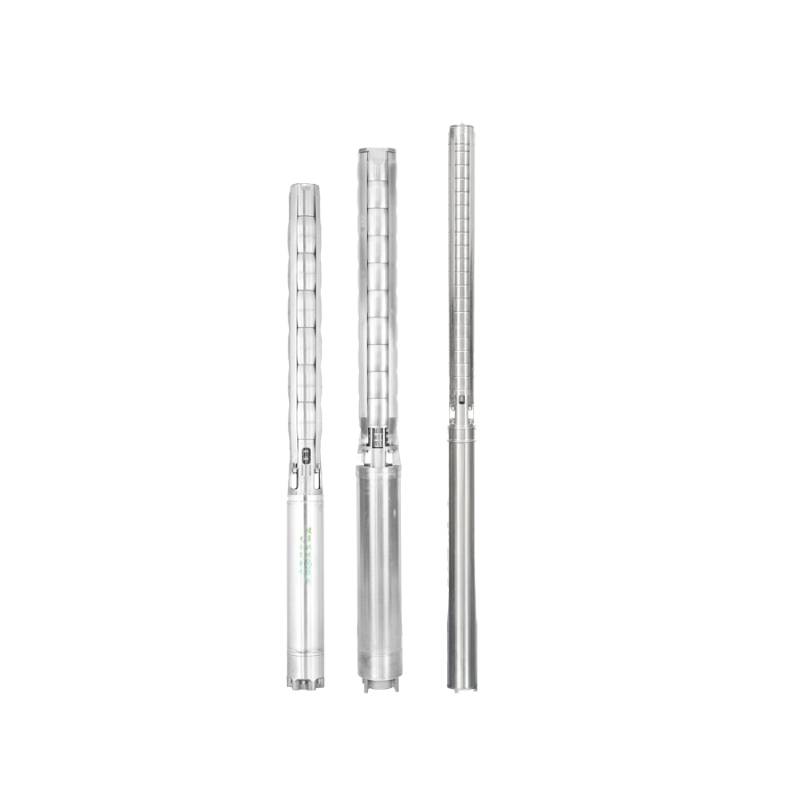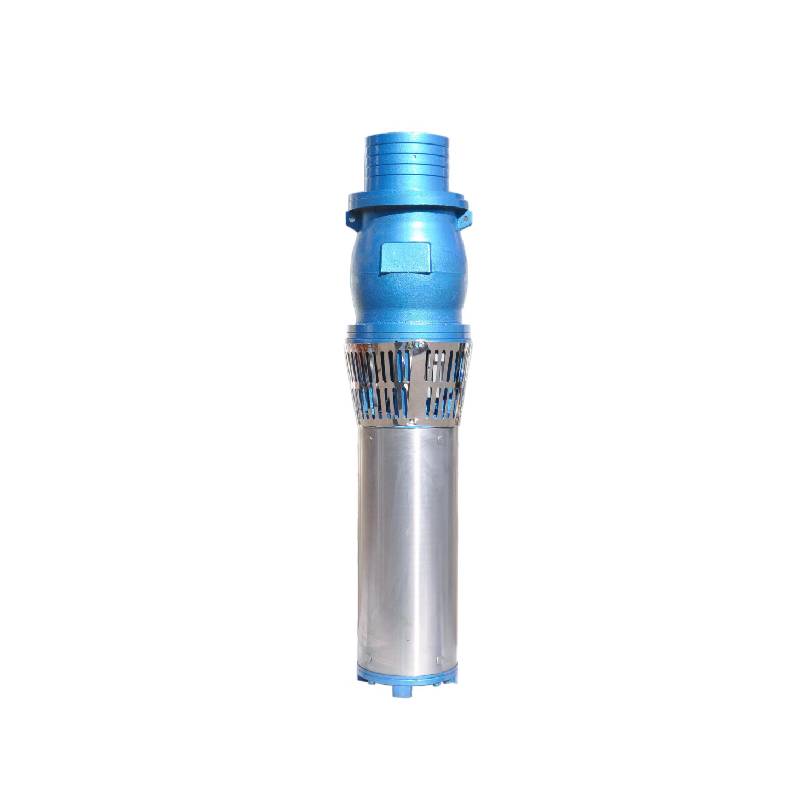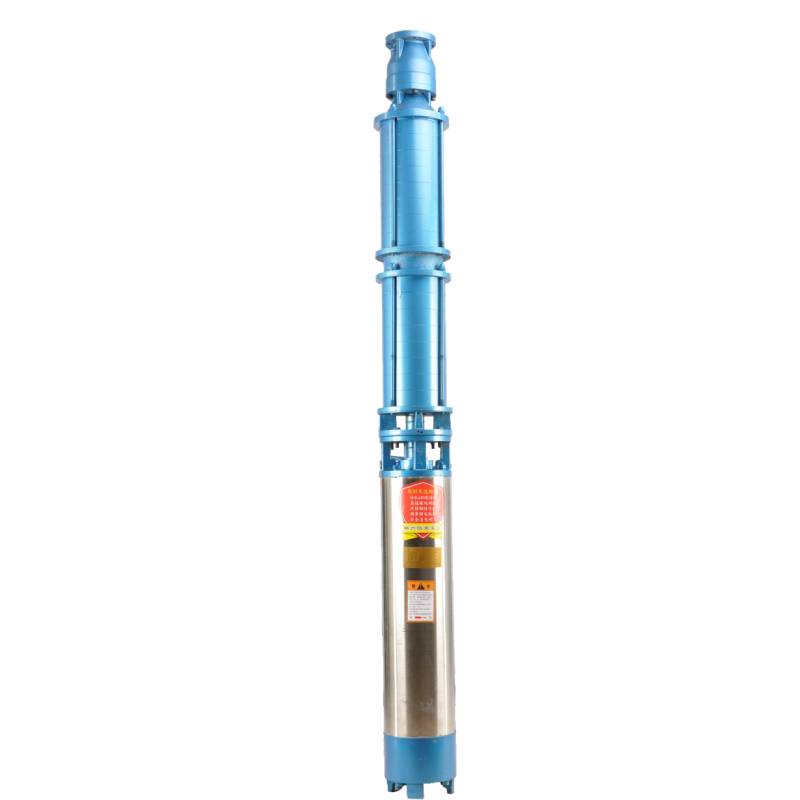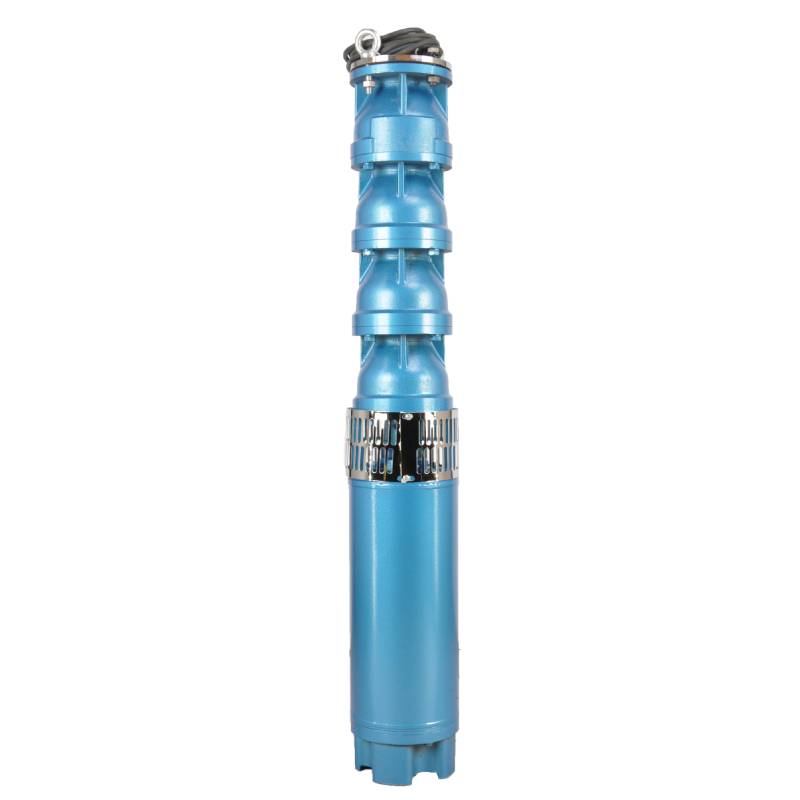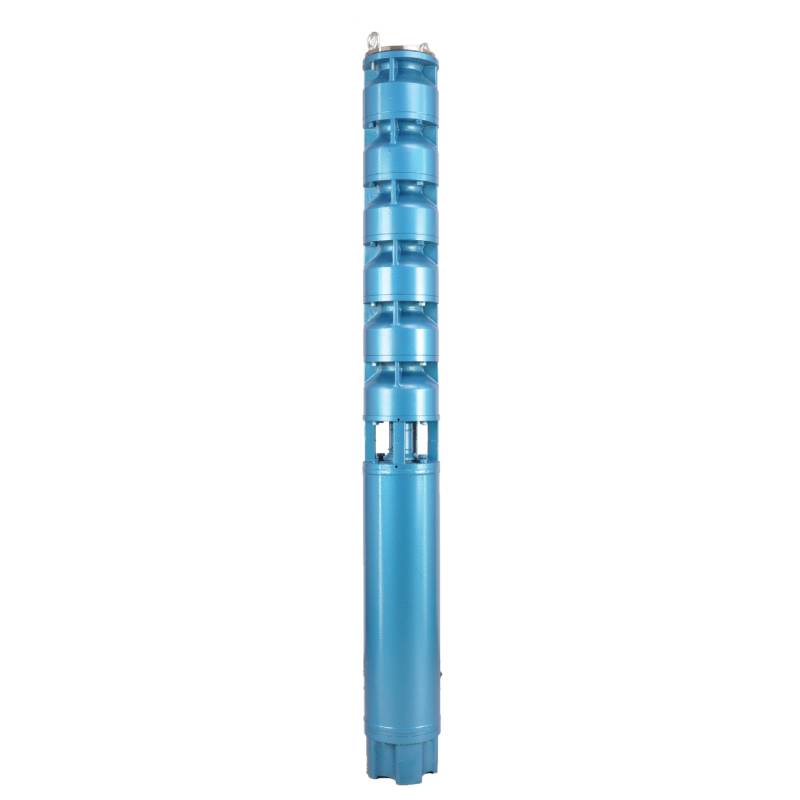QJP series fountain pump is a special pump for fountain developed by our factory.The pump motor core is made of high quality cold rolled silicon steel, which makes the pump more efficient, good magnetic conductivity, and frequent start will not fever.Both ends of the motor rotor use water as lubricant alloy copper sleeve.Stainless steel sleeve instead of ball bearings, to avoid the problem of easy rust ball bearings and lack of oil wear and tear the motor.The most suitable for music fountain use, all models can be used.
This product is a three-phase AC 380V (tolerance + / - 5%), 50HZ (tolerance + / - 1%) power supply system. Applicable water quality conditions include water temperature not exceeding 20 °C, solid impurities content (mass ratio) is not greater than 0.01%, PH value (pH) is 6.5-8.5, hydrogen sulfide content is not greater than 1.5mg/L, chloride ion content is not greater than 400mg/L. The motor is a closed or water-filled wet structure. Before use, it must be filled with clean water to prevent false filling, and then tighten the water injection and exhaust bolts, otherwise it is not allowed to use. The submersible pump must be completely immersed in water, and the penetration depth shall not exceed 70m. The distance between the submersible pump base and the bottom of the well shall not be less than 3m. The well flow shall be able to meet the water output and continuous operation of the submersible pump. The water output of the submersible pump shall be controlled at 0.7-1.2 times of the rated flow. The well shall be vertical, and the submersible pump can not be used horizontally or upside down, but only vertically. The submersible pump shall be equipped with cables and external overload protection devices as required. The pump is strictly prohibited from no-load test without water.
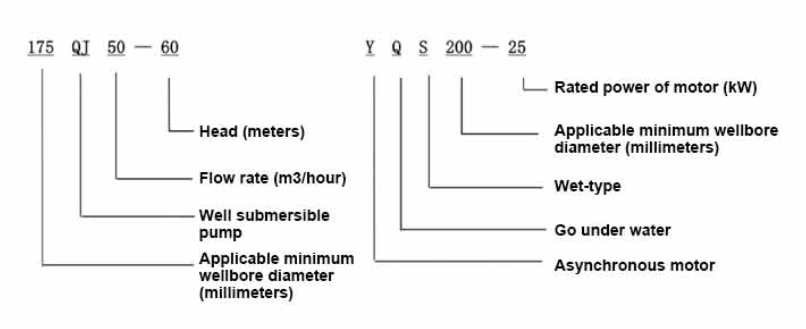
| Mionsamhail | Sreabhadh (m3/u) | Ceann (m) |
Luas rothlaithe (athrú/pointe) |
Caidéal Uisce(%) | Asraon trastomhas (mm) |
Infheidhme go maith trastomhas (mm) |
Rátáilte power(KW) |
Rátáilte voltas(V) |
Rátáilte sruth(A) |
Mótaréifeachtúlacht (%) | power factorcosφ | Aonad Uasmhéid gathach(mm) |
|||||||||
| 175QJ10-42 | 10 | 42 | 2850 | 53 | 50 | 175os cionn | 3 | 380 | 7.8 | 74.0 | 0.79 | 168 | |||||||||
| 175QJ10-56 | 56 | 4 | 10.1 | 76.0 | 0.79 | ||||||||||||||||
| 175QJ10-70 | 70 | 4 | 10.1 | 76.0 | 0.79 | ||||||||||||||||
| 175QJ10-84 | 84 | 5.5 | 13.6 | 77.0 | 0.8 | ||||||||||||||||
| 175QJ10-112 | 112 | 7.5 | 18.4 | 77.5 | 0.8 | ||||||||||||||||
| 175QJ10-126 | 126 | 7.5 | 18.4 | 77.5 | 0.8 | ||||||||||||||||
| 175QJ10-140 | 140 | 9.2 | 22.1 | 78.0 | 0.81 | ||||||||||||||||
| 175QJ15-42 | 15 | 42 | 2850 | 58 | 50 | 175os cionn | 4 | 380 | 10.1 | 76.0 | 0.79 | 168 | |||||||||
| 175QJ15-55 | 55 | 5.5 | 13.6 | 77.0 | 0.8 | ||||||||||||||||
| 175QJ15-65 | 65 | 5.5 | 13.6 | 77.0 | 0.8 | ||||||||||||||||
| 175QJ15-85 | 85 | 7.5 | 18.4 | 77.5 | 0.8 | ||||||||||||||||
| 175QJ15-112 | 112 | 9.2 | 22.1 | 78.0 | 0.81 | ||||||||||||||||
| 175QJ20-26 | 20 | 26 | 2850 | 64 | 50 | 175os cionn | 3 | 380 | 7.8 | 74.0 | 0.79 | 168 | |||||||||
| 175QJ20-39 | 39 | 4 | 10.1 | 76.0 | 0.79 | ||||||||||||||||
| 175QJ20-52 | 52 | 5.5 | 13.6 | 77.0 | 0.8 | ||||||||||||||||
| 175QJ20-78 | 78 | 7.5 | 18.4 | 77.5 | 0.8 | ||||||||||||||||
| 175QJ20-91 | 91 | 9.2 | 22.1 | 78.0 | 0.81 | ||||||||||||||||
| 175QJ20-104 | 104 | 11 | 26.1 | 79.0 | 0.81 | ||||||||||||||||
| 175QJ20-130 | 130 | 13 | 30.1 | 80.0 | 0.82 | ||||||||||||||||
| 175QJ20-156 | 156 | 15 | 34.7 | 80.0 | 0.82 | ||||||||||||||||
| 175QJ20-182 | 187 | 18.5 | 42.6 | 80.5 | 0.82 | ||||||||||||||||
| 175QJ20-208 | 208 | 22 | 49.7 | 81.0 | 0.83 | ||||||||||||||||
| 175QJ20-247 | 247 | 25 | 56.5 | 81.0 | 0.83 | ||||||||||||||||
| 175QJ20-273 | 273 | 30 | 66.6 | 81.5 | 0.84 | ||||||||||||||||
| 175QJ20-299 | 299 | 30 | 66.6 | 81.5 | 0.84 | ||||||||||||||||
| 175QJ20-325 | 325 | 32 | 71.0 | 81.5 | 0.84 | ||||||||||||||||
| 175QJ20-364 | 364 | 37 | 82.1 | 81.5 | 0.84 | ||||||||||||||||
| 175QJ25-26 | 25 | 26 | 2850 | 66 | 65 | 175os cionn | 3 | 380 | 7.8 | 74.0 | 0.79 | 168 | |||||||||
| 175QJ25-39 | 39 | 5.5 | 13.6 | 77.0 | 0.8 | ||||||||||||||||
| 175QJ25-65 | 25 | 65 | 2850 | 66 | 65 | 175os cionn | 7.5 | 380 | 18.4 | 77.5 | 0.8 | 168 | |||||||||
| 175QJ25-78 | 78 | 9.2 | 22.1 | 78.0 | 0.81 | ||||||||||||||||
| 175QJ25-91 | 91 | 11 | 26.1 | 79.0 | 0.81 | ||||||||||||||||
| 175QJ25-104 | 104 | 13 | 30.1 | 80.0 | 0.82 | ||||||||||||||||
| 175QJ25-130 | 130 | 15 | 34.7 | 80.0 | 0.82 | ||||||||||||||||
| 175QJ25-156 | 156 | 18.5 | 42.6 | 80.5 | 0.82 | ||||||||||||||||
| 175QJ25-182 | 182 | 22 | 49.7 | 81.0 | 0.83 | ||||||||||||||||
| 175QJ25-208 | 208 | 25 | 56.5 | 81.0 | 0.83 | ||||||||||||||||
| 175QJ25-221 | 221 | 30 | 66.6 | 81.5 | 0.84 | ||||||||||||||||
| 175QJ25-247 | 247 | 30 | 66.6 | 81.5 | 0.84 | ||||||||||||||||
| 175QJ25-260 | 260 | 32 | 71.0 | 81.5 | 0.84 | ||||||||||||||||
| 175QJ25-299 | 299 | 37 | 82.1 | 81.5 | 0.84 | ||||||||||||||||
| 175QJ30-30 | 30 | 30 | 2850 | 67 | 80 | 175os cionn | 4 | 380 | 10.1 | 76.0 | 0.79 | 168 | |||||||||
| 175QJ30-40 | 40 | 5.5 | 13.6 | 77.0 | 0.8 | ||||||||||||||||
| 175QJ32-24 | 32 | 24 | 2850 | 67 | 80 | 175os cionn | 4 | 380 | 10.1 | 76.0 | 0.79 | 168 | |||||||||
| 175QJ32-36 | 36 | 5.5 | 13.6 | 77.0 | 0.8 | ||||||||||||||||
| 175QJ32-48 | 48 | 7.5 | 18.4 | 77.5 | 0.8 | ||||||||||||||||
| 175QJ32-60 | 60 | 9.2 | 22.1 | 78.0 | 0.81 | ||||||||||||||||
| 175QJ32-72 | 72 | 11 | 26.1 | 79.0 | 0.81 | ||||||||||||||||
| 175QJ32-84 | 84 | 13 | 30.1 | 80.0 | 0.82 | ||||||||||||||||
| 175QJ32-96 | 96 | 15 | 34.7 | 80.0 | 0.82 | ||||||||||||||||
| 175QJ32-120 | 120 | 18.5 | 42.6 | 80.5 | 0.82 | ||||||||||||||||
| 175QJ32-144 | 144 | 22 | 49.7 | 81.0 | 0.83 | ||||||||||||||||
| 175QJ32-168 | 168 | 25 | 56.5 | 81.0 | 0.83 | ||||||||||||||||
| 175QJ32-180 | 180 | 30 | 66.6 | 81.5 | 0.84 | ||||||||||||||||
| 175QJ32-192 | 192 | 30 | 66.6 | 81.5 | 0.84 | ||||||||||||||||
| 175QJ32-204 | 204 | 32 | 71.0 | 81.5 | 0.84 | ||||||||||||||||
| 175QJ32-240 | 240 | 37 | 82.1 | 81.5 | 0.84 | ||||||||||||||||
| 175QJ35-60 | 35 | 60 | 2850 | 67 | 80 | 175os cionn | 10 | 380 | 25.0 | 78.0 | 0.78 | 168 | |||||||||
| 175QJ35-75 | 75 | 13 | 30.1 | 80.0 | 0.82 | ||||||||||||||||
| 175QJ35-100 | 100 | 17 | 40.9 | 80.0 | 0.79 | ||||||||||||||||
| 175QJ40-24 | 40 | 24 | 2850 | 70 | 80 | 175os cionn | 5.5 | 380 | 13.6 | 77.0 | 0.8 | 168 | |||||||||
| 175QJ40-30 | 30 | 5.5 | 13.6 | 77.0 | 0.8 | ||||||||||||||||
| 175QJ40-36 | 36 | 7.5 | 18.4 | 77.5 | 0.8 | ||||||||||||||||
| 175QJ40-48 | 48 | 9.2 | 22.1 | 78.0 | 0.81 | ||||||||||||||||
| 175QJ40-60 | 60 | 11 | 26.1 | 79.0 | 0.81 | ||||||||||||||||
| 175QJ40-72 | 72 | 13 | 30.1 | 80.0 | 0.82 | ||||||||||||||||
| 175QJ40-84 | 84 | 15 | 34.7 | 80.0 | 0.82 | ||||||||||||||||
| 175QJ40-96 | 96 | 18.5 | 42.6 | 80.5 | 0.82 | ||||||||||||||||
| 175QJ40-120 | 120 | 22 | 49.7 | 81.0 | 0.83 | ||||||||||||||||
| 175QJ40-132 | 132 | 25 | 56.5 | 81.0 | 0.83 | ||||||||||||||||
| 175QJ40-144 | 144 | 30 | 66.6 | 81.5 | 0.84 | ||||||||||||||||
| 175QJ40-156 | 156 | 30 | 66.6 | 81.5 | 0.84 | ||||||||||||||||
| 175QJ40-168 | 168 | 32 | 71.0 | 81.5 | 0.84 | ||||||||||||||||
| 175QJ40-192 | 192 | 37 | 82.1 | 81.5 | 0.84 | ||||||||||||||||
| 175QJ50-24 | 50 | 24 | 2850 | 72 | 80 | 175os cionn | 5.5 | 380 | 13.6 | 77.0 | 0.8 | 168 | |||||||||
| 175QJ50-36 | 36 | 9.2 | 22.1 | 78.0 | 0.81 | ||||||||||||||||
| 175QJ50-48 | 48 | 11 | 26.1 | 79.0 | 0.81 | ||||||||||||||||
| 175QJ50-60 | 60 | 13 | 30.1 | 80.0 | 0.82 | ||||||||||||||||
| 175QJ50-70 | 70 | 17 | 40.9 | 80.0 | 0.79 | ||||||||||||||||
| 175QJ50-84 | 84 | 18.5 | 42.6 | 80.5 | 0.82 | ||||||||||||||||
| 175QJ50-96 | 96 | 22 | 49.7 | 81.0 | 0.83 | ||||||||||||||||
| 175QJ50-108 | 108 | 25 | 56.5 | 81.0 | 0.83 | ||||||||||||||||
| 175QJ50-120 | 120 | 30 | 66.6 | 81.5 | 0.84 | ||||||||||||||||
| 175QJ50-132 | 132 | 30 | 66.6 | 81.5 | 0.84 | ||||||||||||||||
| 175QJ50-144 | 144 | 32 | 71.0 | 81.5 | 0.84 | ||||||||||||||||
| 175QJ50-156 | 156 | 37 | 82.1 | 81.5 | 0.84 | ||||||||||||||||
| 175QJ63-22 | 63 | 22 | 2850 | 72 | 80 | 175os cionn | 7.5 | 380 | 18.4 | 77.5 | 0.8 | 168 | |||||||||
| 175QJ63-44 | 44 | 13 | 30.1 | 80.0 | 0.82 | ||||||||||||||||
| 175QJ63-55 | 55 | 15 | 34.7 | 80.0 | 0.82 | ||||||||||||||||
| 175QJ63-66 | 66 | 18.5 | 42.6 | 80.5 | 0.82 | ||||||||||||||||
| 175QJ63-77 | 77 | 22 | 49.7 | 81.0 | 0.83 | ||||||||||||||||
| 175QJ63-88 | 88 | 25 | 56.5 | 81.0 | 0.83 | ||||||||||||||||
| 175QJ63-99 | 63 | 99 | 2850 | 72 | 80 | 175os cionn | 30 | 380 | 66.6 | 81.5 | 0.84 | 168 | |||||||||
| 175QJ63-110 | 110 | 32 | 71.0 | 81.5 | 0.84 | ||||||||||||||||
| 175QJ63-132 | 132 | 37 | 82.1 | 81.5 | 0.84 | ||||||||||||||||
| 175QJ80-9 | 80 | 9 | 2850 | 73 | 100 | 175os cionn | 4 | 380 | 10.1 | 76.0 | 0.79 | 168 | |||||||||
| 175QJ80-18 | 18 | 7.5 | 18.4 | 77.5 | 0.8 | ||||||||||||||||
| 175QJ80-27 | 27 | 11 | 26.1 | 79.0 | 0.81 | ||||||||||||||||
| 175QJ80-36 | 36 | 15 | 34.7 | 80.0 | 0.82 | ||||||||||||||||
| 175QJ80-45 | 45 | 18.5 | 42.6 | 80.5 | 0.82 | ||||||||||||||||
| 175QJ80-54 | 54 | 22 | 49.7 | 81.0 | 0.83 | ||||||||||||||||
| 175QJ80-63 | 63 | 25 | 56.5 | 81.0 | 0.83 | ||||||||||||||||
| 175QJ80-72 | 72 | 25 | 56.5 | 81.0 | 0.83 | ||||||||||||||||
| 175QJ80-81 | 81 | 30 | 66.6 | 81.5 | 0.84 | ||||||||||||||||
| 175QJ80-90 | 90 | 32 | 71.0 | 81.5 | 0.84 | ||||||||||||||||
| 175QJ80-98 | 98 | 37 | 82.1 | 81.5 | 0.84 | ||||||||||||||||
1, well submersible pump for clean water pump, prohibit the new well, pumping sediment and muddy water,
2, well water pump voltage grade of 380/50HZ, the use of other voltage grades of submersible motors need to be customized. The underground cable must use waterproof cable, must be equipped with starting equipment, such as distribution box, start not ready should have commonly used motor comprehensive protection function, such as short circuit overload protection, phase protection, undervoltage protection, grounding protection, idling protection, in case of abnormal conditions, the protection device should be timely action trip.
3, the installation and use of the pump must be reliably grounded, prohibit the push and pull switch when the hands and feet are wet, the installation and maintenance of the pump must be cut off the power supply, the use of the pump place to set up "to prevent electric shock" obvious signs:
4, down the well or before installation, the motor cavity must be filled with distilled water or non-corrosive clean cold boiling water, tighten the / water bolt, the pump on the ground test run, must be to the pump chamber water lubrication rubber bearings, instant start not more than a second, see whether the steering is the same as the steering instructions. When the pump is upright, pay attention to safety, prevent overturning injury.
5, go docht de réir fhorálacha an ardaitheoir caidéil, raon sreafa úsáide, chun cosc a chur ar shreabhadh íseal nó fórsa caidéalaithe ard-ardaitheoir, an t-imthaca sá agus páirteanna eile den chaitheamh, an ró-ualach mótair dóite
6, after the pump down the well, the measurement of the motor to the ground insulation resistance should not be less than 100M, after the start to observe the voltage and current, check the motor winding insulation, whether in line with the requirements; pump storage location temperature if less than freezing point, should be dry the motor cavity water, prevent the motor cavity water ice damage caused by low temperature.
The pump part is mainly composed of pump shaft, impeller, shunt shell, rubber bearing, check valve body (optional) and other components. The motor part mainly includes base, pressure regulating diaphragm, thrust bearing, thrust plate, lower guide bearing seat, stator, rotor, upper guide bearing seat, sand ring, water inlet section, lead cable and other components. The main features of the product include: the motor is a water immersed wet three-phase asynchronous motor, the motor cavity is full of water, used to cool the motor and lubricate the bearing; the pressure regulating film at the bottom of the motor is used to adjust the expansion and contraction pressure difference of the internal water caused by the change of temperature; in order to prevent the sand particles in the well water from entering the motor, two oil seals are installed on the upper end of the motor shaft extension, and a sand control structure is formed by installing the sand ring; in order to prevent the pump shaft from jumping at startup, the pump shaft is connected with the motor shaft through a coupling, and the thrust bearing is installed under the motor; the lubrication of the motor and the pump bearing is water lubrication; the stator winding of the motor is made of high quality submersible motor winding, with high insulation performance; the pump is designed by computer CAD, with simple structure and excellent technical performance.

(1) Ullmhúchán roimh shuiteáil:
1. Seiceáil an gcomhlíonann an caidéal báite na coinníollacha úsáide agus an raon feidhme a shonraítear sa lámhleabhar.
2. Ag baint úsáide as obiect trom le trastomhas comhionann le trastomhas seachtrach uasta an chaidéil báite, tomhais an féidir le trastomhas inneldiameter an tobair an caidéal báite a fheistiú, agus tomhas an gcomhlíonann doimhneacht an tobair na ceanglais suiteála.
3. Seiceáil an bhfuil tolladh an tobair glan agus an bhfuil uisce an tobair suaite. Ná húsáid caidéal leictreach intumtha riamh chun láib agus gaineamh an chaidéil welor a ní chun damáiste roimh am a sheachaint don chaidéal leictreach intumtha.
4. Seiceáil an bhfuil suíomh an clamp suiteála welhead oiriúnach agus an féidir leis cáilíocht an aonaid iomláin a sheasamh
5. Seiceáil an bhfuil na comhpháirteanna caidéil báite críochnaithe agus suiteáilte i gceart de réir an léaráid tionóil sa lámhleabhar Bain an scáileán scagaire agus rothlaigh an cúpláil féachaint an rothlaíonn sé go solúbtha
6. Díscriú an scriú uisce agus líon an cuas mótair le huisce glan, neamhchreimneach (tabhair faoi deara. Bí cinnte é a chomhdú), ansin déan an scriú uisce níos doichte. Tar éis 12 uair an chloig d'instealladh uisce, níor chóir go mbeadh friotaíocht inslithe an mhótair níos lú ná 150M Q nuair a thomhaistear é le tábla croith 500V.
7. Cable joint, cut off a 120mm rubber sleeve from one end of the outgoing cable and the matching cable with an electrician's knifethen stagger the length of the three core wires in a stepped shape, peel off a 20mm copper core, scrape of the oxide layer on theoutside of the copper wire with a knife or sand cloth, and insert the two connected wire ends in palirs.After tying the layer tightly with fine copper wire, solder it thoroughly and firmly, and sand of any. burrs on the surface. Then, forthe three joints, use polyvester insulation tape to wrap them in a semi stacked manner for three lavers. Wrap the two ends of thewrapping layer tightywith nyion thread,and then use a semi stacked method to wrap the tape for three layers. Wrap the outellayer with high-pressure insulation tape for three layers. Finally, fold the threestrands together and repeatedly wrap them for fivelayers with high-pressure tape. Each layer must be tightly tied, and the interlayer joints must be tight and fimm to prevent water frompenetrating and damaging the insulation, After wrapping, soak in water at room temperature of 20 ’c for 12 hours, and measurethe insulation resistance with a shaking table, which should not be less than 100M Ω
Is é seo a leanas an léaráid próiseas sreangú cábla ceangailte: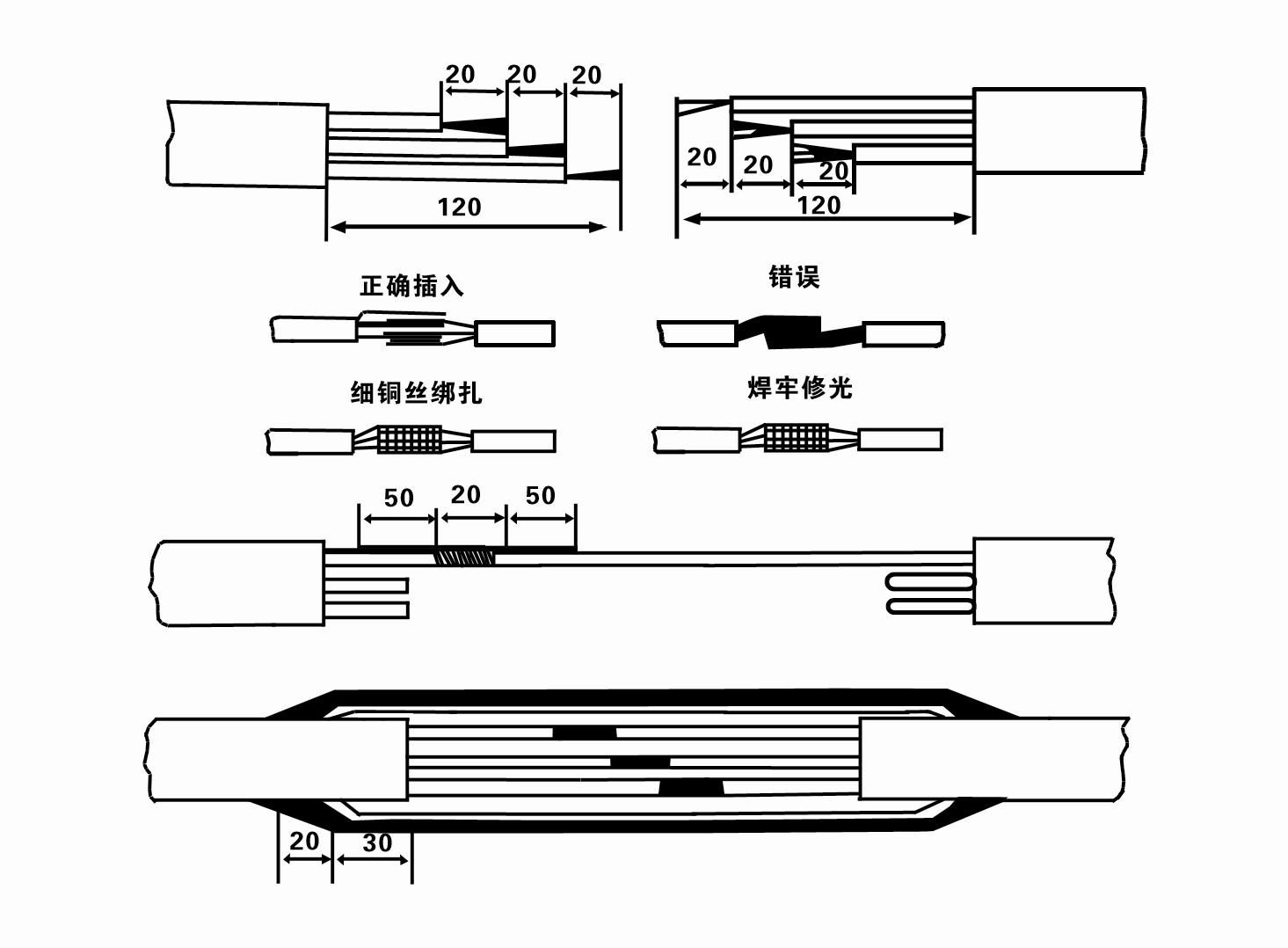
8. Bain úsáid as multimeter chun a sheiceáil an bhfuil na sreanga trí chéim ceangailte agus an bhfuil an fhriotaíocht DC cothromaithe thart.
9. Seiceáil an bhfuil an ciorcad agus an cumas claochladáin ró-ualach, agus ansin an lasc cosanta ró-ualach nó an trealamh tosaigh a nascadh. Féach Tábla 2 le haghaidh samhlacha sonracha, agus ansin Doirt buicéad uisce isteach sa chaidéal uisce ón asraon caidéil uisce chun na imthacaí rubair a lubricadh sa chaidéal, agus ansin cuir an caidéal leictreach intumtha ina seasamh agus go seasta.Start (gan níos mó ná soicind amháin) agus seiceáil an bhfuil an treo stiúrtha comhsheasmhach leis an gcomhartha stiúrtha. Mura bhfuil, babhtáil aon dá chónaisc den chábla trí phas. Ansin shuiteáil an scagaire agus ullmhaigh tú chun dul síos ar an tobar. Má úsáidtear é in ócáidí speisialta (cosúil le díoga, díoga, aibhneacha, locháin, locháin, etc.), ní mór an caidéal leictreach a thalamh go hiontaofa.
(2) Trealamh agus uirlisí suiteála:
1. Péire amháin de slabhraí ardaithe ar feadh níos mó ná dhá tonna.
2. Tripod le airde ingearach nach lú ná ceithre mhéadar.
3. Dhá rópa crochta (rópaí sreang) ar féidir leo meáchan níos mó ná tonna amháin a iompróidh (is féidir meáchan sraith iomlán caidéil uisce a iompróidh).
4. Suiteáil dhá phéire teanntáin (splints).
5. Wrenches, casúir, scriúirí, uirlisí leictreacha agus ionstraimí, etc.
(3) Suiteáil caidéil leictreacha:
1. Taispeántar léaráid suiteála an chaidéil leictreacha intumtha i bhFíor 2. Taispeántar na toisí suiteála sonracha i dTábla 3 "Liosta Toisí Suiteála an Chaidéil Leictreach Intumtha".
2. Is féidir caidéil leictreacha báite le ceann níos lú ná 30 méadar a ardú go díreach isteach sa tobar ag baint úsáide as píobáin agus rópaí sreang nó rópaí cnáib eile ar féidir leo meáchan iomlán an mheaisín iomláin, píopaí uisce, agus uisce sna píopaí a iompar.
3. Úsáideann caidéil le ceann níos mó ná 30 méadar píopaí cruach, agus is é seo a leanas an t-ord suiteála:
① Bain úsáid as clamp chun ceann uachtarach an chaidéil uisce a chlampáil (tá an mótar agus an caidéal uisce ceangailte ag an am seo), ardaigh sé le slabhra crochta, agus ceangail go mall isteach sa tobar é go dtí go gcuirfidh tú an clamp ar cheann an tobair agus bain an slabhra crochta.
② Bain úsáid as péire teanntáin eile chun píopa a chlampáil, é a ardú le slabhra crochta 15 cm ar shiúl ón flange, agus é a ísliú go mall. Idir flange píopa agus flange caidéil Cuir an ceap rubair in áit agus déan an píopa agus an caidéal a dhéanamh níos doichte go cothrom le boltaí, cnónna agus leicneáin earraigh.
③ Ardaigh an caidéal báite beagán, bain an clamp ar thaobh uachtarach an chaidéil uisce, ceangail an cábla go daingean leis an bpíobán uisce le téip plaisteach, agus é a cheangal go mall síos go dtí go gcuirtear an clamp ag ceann an tobair.
④ Bain úsáid as an modh céanna chun na píopaí uisce go léir a cheangal isteach sa tobar.
⑤ Tar éis an cábla luaidhe-amach a bheith ceangailte leis an lasc rialaithe, tá sé ceangailte leis an soláthar cumhachta trí phas.
(4) Rudaí le tabhairt faoi deara le linn na suiteála:
1. Má aimsítear feiniméan jamming le linn an phróisis caidéalaithe, cas nó tarraing an píopa uisce chun an pointe jamming a shárú. Mura n-oibríonn bearta éagsúla fós, le do thoil Ná cuir an caidéal síos chun damáiste a sheachaint don chaidéal leictreach intumtha agus don tobar.
2. Le linn na suiteála, ba chóir eochaircheap rubair a chur ar flange gach píopa agus é a cheangal go cothrom.
3. Nuair a íslítear an caidéal uisce isteach sa tobar, ba chóir é a chur i lár an phíobáin tobair chun an caidéal a chosc ó bheith ag rith i gcoinne bhalla an tobair ar feadh i bhfad, rud a fhágann go mbeidh an caidéal ag creathadh agus an mótar a scuabadh agus a dhó. .
4. Déan doimhneacht an chaidéil uisce go bun an tobair a chinneadh de réir coinníollacha sreafa gaineamh agus siolta an tobair. Ná cuir an caidéal sa láib. De ghnáth ní lú ná 3 mhéadar an fad ón gcaidéal uisce go bun an tobair (féach Fíor 2).
5. Níor cheart go mbeadh doimhneacht iontrála uisce an chaidéil uisce níos lú ná 1-1.5 méadar ón leibhéal uisce dinimiciúil go dtí an nód inlet uisce (féach Fíor 2). Seachas sin, féadfar damáiste a dhéanamh go héasca ar imthacaí an chaidéil uisce.
6. Ní féidir le hardaitheoir an chaidéil uisce a bheith ró-íseal. Seachas sin, is gá comhla geata a shuiteáil ar phíblíne uisce an tobair chun sreabhadh an chaidéil ag an bpointe sreafa rátáilte a rialú chun an mótar a chosc ó ró-ualach agus a dhó mar gheall ar rátaí sreafa móra.
7. Nuair a bhíonn an caidéal uisce ag rith, ba cheart go mbeadh an t-aschur uisce leanúnach agus fiú, ba cheart go mbeadh an sruth cobhsaí (faoi choinníollacha oibre rátáilte, go ginearálta gan níos mó ná 10% den sruth rátáilte), agus níor cheart go mbeadh aon chreathadh nó torann ann. Má tá aon neamhghnáchaíocht ann, ba chóir an meaisín a stopadh chun an chúis a fháil amach agus é a dhíchur.
8. Nuair a shuiteáil tú, tabhair aird ar shocrú na sreinge talún mótair (féach Fíor 2). Nuair is píopa cruach é an píopa uisce, déan é a threorú as clamp an tobair; nuair is píopa plaisteach an píopa uisce, é a threorú ó mharc talún an chaidéil leictreach.
- 1.After installing the submersible pump, recheck the insulation resistance and the three-phase continuity at the switch, and check whether there are errors in the connection of the instrument and the starting equipment.If there are no problems, you can start to test the machine. After starting, observe whether the indication readings of each instrument are correct. If the rated voltage and current specified on the nameplate are exceeded, observe whether the pump emits any noise or vibration. If everything is normal, it can be put into operation.
- 2. After the pump runs for the first four hours, the thermal insulation resistance of the motor should be closed and tested quickly.Its value should not be less than 0.5 megaohm.After the pump stops, it should be restarted after an interval of five minutes to prevent the water column in the pipeline from completely reversing and burning the motor due to excessive current.
- 3. After the pump is put into normal operation, in order to prolong its service life, it is necessary to check regularly whether the supply voltage, working current and insulation resistance are normal. If the following conditions are found, the machine should be stopped immediately to troubleshoot.
- 1 Sa riocht oibre rátáilte, tá an reatha níos mó ná 20%.
- 2 Titeann an leibhéal uisce dinimiciúil go dtí an t-alt inlet uisce, rud a fhágann go bhfuil uisce uaineach.
- 3 Tá creathadh nó torann trom ag an gcaidéal báite.
- 4 Tá an voltas soláthair níos ísle ná 340 volta.
- 5 Tá fiús dóite amach.
- 6 Déantar damáiste don phíobán soláthair uisce.
- 7 Tá friotaíocht inslithe an mhótair go dtí an stát geoiteirmeach níos ísle ná 0.5 megaohm.
- Unit disassembly:
- 1.untie cable rope, remove the pipeline part, remove the wire plate.
- 2.screw down the water bolt, put the water in the motor chamber.
- 3.remove the filter, loose the fixed screw on the coupling to fix the motor shaft.
- 4.screw down the bolt connecting the inlet junction with the motor, and separate the pump from the motor (pay attention to the unit cushion when separating, to prevent the bending of the pump shaft)
- 5.the disassembly sequence of the pump is: (see figure 1) inlet junction, impeller, diversion shell, impeller...... check valve body, when removing the impeller, use special tools to loosen the conical sleeve of the fixed impeller first, and avoid bending and bruising of the pump shaft in the process of disassembly.
- 6.the disassembly process of the motor is: (see figure 1) place the motor on the platform, and remove the nuts, base, shaft head locking nut, thrust plate, key, lower guide bearing seat and double head bolt from the bottom of the motor in turn, and then take out the rotor (pay attention not to damage the wire package) and finally remove the connecting section and upper guide bearing seat.
- 7.unit assembly: before assembly, the rust and dirt of the parts should be cleaned, and the mating surface and fasteners coated with sealant, and then assembled in the reverse order of disassembly (the motor shaft moves up and down after assembly for about one millimeter), after assembly, the coupling should be flexible, and then the filter screen test machine. Submersible pumps shall be taken out of the well for dismantling and maintenance according to Article 5 after a year of operation, or less than a year of operation but two years of diving time, and the worn parts shall be replaced.
This product adopts advanced design and provides advanced storage suggestions to ensure long-term use effect.First of all, in winter, it is necessary to exhaust all the water to prevent freezing. In addition, the wire rolls should be placed well and tied up.Secondly, when storing, the environment without corrosive action and gas should be selected and the temperature should be kept below 40 °C. Finally, when not used for a long time, attention should be paid to prevent rust of submersible pump.These storage requirements will ensure that the product can maintain its performance status and prolong its service life for a long time.
- Impeallóir
- Muinchille seafta
- Muinchille seafta rubair
-
Fáinne séalaithe
01 Iontógáil uisce domhain tobair
02 Soláthar uisce ard-ardú
03 soláthar uisce sléibhe
04 túr uisce
05 Uisciúcháin talmhaíochta
06 uisciúcháin gairdín
07 iontógáil uisce abhann
08 uisce tí



